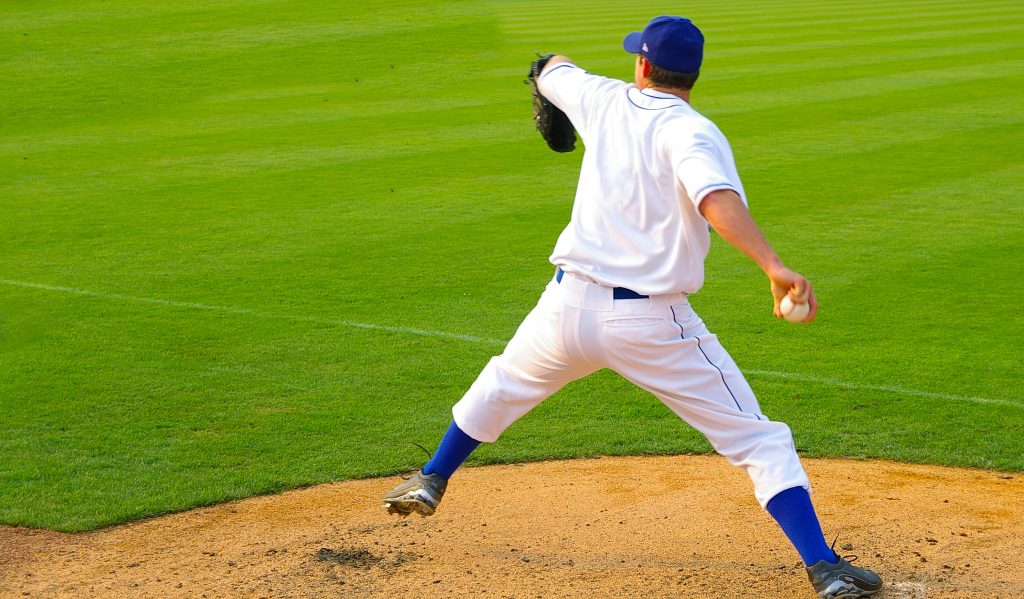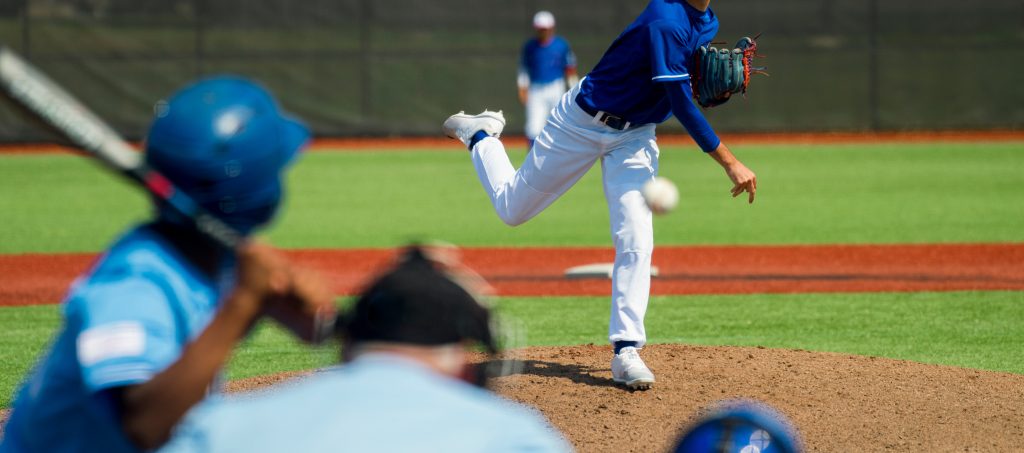Ulnar collateral ligament (UCL) injuries are often due to vigorous throwing activities—especially in baseball. In fact, UCL reconstruction surgery is named for a famous baseball pitcher. The complex elbow surgery was performed by Dr. Frank Jobe, MD, and it has been referred to as “Tommy John surgery” ever since. It is used to restore strength and stability to the elbow after the ligament located on the inside of the elbow is torn or sprained. This procedure includes repairing the remaining ligament and augmenting it with a new tendon graft. The tendon graft is most commonly harvested from the athlete’s forearm or knee.
The ulnar collateral ligament is a band of tissue on the inside (medial side) of the elbow. Ligaments connect bones to one another, and the UCL connects the upper arm bone (humerus) to a bone in the forearm (ulna). The ulna is one of two bones in the forearm, the other being the radius. Together, the upper arm bone and the forearm bones meet to form the hinge-type joint of the elbow.
The stress placed on the elbow during a fastball is an extreme version of what can happen to the elbow joint with repetitive motions over time. Whether you excel in gymnastics, wrestling, baseball, or javelin, repetitive stress on the elbow can cause swelling, cartilage damage, bone spurs, and tearing of the UCL. Less commonly, a sudden excessive force on the elbow can cause a tear of the UCL without any prior symptoms.

“Ulnar collateral ligament reconstruction surgery is used to restore strength and stability to the elbow after the UCL is torn or sprained.”
Why treatment is required
UCL injuries are often very painful, especially if they occur suddenly (acutely), rather than with a gradual fraying or tearing of the ligament over time (chronically). Those who report a sudden injury often describe hearing a popping noise and feeling a clicking or grinding sensation in the joint. These injuries can also cause swelling and bruising.
People with an injured UCL will notice a loss of throwing velocity and control. They may have pain in the inner elbow and they may have symptoms of nerve irritation like numbness and tingling in the forearm and hand. Diagnosis includes a careful physical examination followed by confirmation with MRI.
In general, more severe cases of UCL injury will require surgery. In the past, Tommy John surgery was usually reserved for professional athletes whose elbows had been overworked. However, an alarming and growing number of young athletes have undergone this surgery, with the greatest increase occurring in athletes 15–19 years old. Many of these cases are thought to be due to young athletes exceeding pitch count recommendations and the relentless pursuit of increased velocity when throwing a baseball such as training with a weighted ball. (Dr. Romeo discusses youth sports injury prevention in this video.)
A non-athlete may be able to treat the injury without surgery by resting the elbow, avoiding activities that place stress on the joint, and following a course of physical therapy to strengthen the muscles that support the ligament. High-profile athletes, especially baseball pitchers, frequently opt for Tommy John surgery to restore their strength, stability, and throwing velocity.
How treatment is performed
During UCL reconstruction, the inside (medial side) of the elbow is opened and the surgeon carefully moves the ulnar nerve and healthy tissues out of the way. The damaged UCL is often left in place. A tunnel is drilled into the ulna, a socket is created in the humerus, and the tendon graft will be attached at these two points.
The tendon graft is usually taken from the patient’s own forearm of the same arm (palmaris longus) or from the patient’s hamstring (gracilis). Thick, high-strength stitches (sutures) are sewn through the ends of the tendon. These sutures are then woven through the holes in the ulna and then secured in the socket of the humerus. The tendon graft is sewn together with the patient’s injured UCL to provide extra strength and promote healing of the graft. Recently, Dr. Romeo has developed a technique where he adds a synthetic tape that acts as an internal brace to support the repair and help with faster healing.
If the patient was experiencing signs of ulnar nerve problems before the surgery (weakness in the hand, tingling/numbness in the ring and pinky fingers), then the surgeon is likely to move the ulnar nerve from the back to the front of the elbow so it is no longer being pinched or compressed.
Want to learn more? In this video, Dr. Romeo describes Tommy John surgery:
Want to watch the procedure?
Here is a full-length video of a UCL reconstruction. Watch an animation of Tommy John surgery here.
Risks and benefits
Ulnar collateral ligament reconstruction surgery can carry risks of:
- Nerve or blood vessel damage, leading to temporary or permanent numbness or weakness
- Infection
- Reaction to anesthesia
- Stiffness of the elbow
- Stretching or tearing of the graft
- Elbow fracture of the humerus (related to the bone socket that was made during surgery)
- Worsening of the ulnar nerve symptoms (weakness, numbness, tingling)
UCL surgery may not be recommended if your lifestyle or job doesn’t demand a lot of stress on the elbow or if nonsurgical treatments are able to relieve your pain. However, for most athletes, surgery is critical to returning to the game.
“A rehabilitation period is required to allow the body to adapt to the transplanted tendon and to prevent further injury.”

Physical therapy protocols
During your recovery, physical therapy will help you build strength and sharpen muscular coordination. At home, you will ease into an exercise routine focused on increasing the range of motion of your elbow, wrist, and shoulder. Athletes should improve their core muscle strength and throwing mechanics to help prevent recurrence of injury.
Tommy John Surgery Physical Therapy Protocol
Pain control
A regional nerve block is administered using 20–40 mL of local anesthetic to “freeze” the area being operated on. The nerve block is long-lasting and works for approximately 12–18 hours after surgery. Dr. Romeo uses ultrasound guidance for the safe and effective placement of the medication for the nerve block.
As the nerve block gradually wears off, oral pain medications (pills or tablets) may be used to manage any discomfort. Dr. Romeo uses a variety of pain-control methods (multimodal analgesia) , such as Tylenol Extra Strength (acetaminophen) and nonsteroidal anti-inflammatory drugs such as Naprosyn (naproxen) or Mobic (meloxicam). Cold therapy or ice at the surgical site can also help reduce swelling, pain, and the need for medications.
Dr. Romeo provides each patient with specific instructions to manage any post-op pain, including enhanced recovery after surgery (ERAS) protocols. Dr. Romeo has managed thousands of surgeries and has detailed pain management plans for all of his patients. He is also committed to managing their pain responsibly to minimize the risk of opioid addiction.
Recovery time
If you undergo Tommy John surgery, you will be sent home in an elbow brace that keeps the joint immobile for about ten days. After that time, you will be allowed to move your elbow gently but continue to wear the brace for a total of four weeks from the date of surgery.
A rehabilitation period is required to allow the body to adapt to the transplanted tendon and to prevent further injury. The total time for full rehabilitation depends on the sport and position the athlete plays. For baseball pitchers, return to competitive throwing is nine to twelve months; however, return to the pre-injury level of performance is typically twelve to fifteen months. The actual rehabilitation period will be determined on a case-by-case basis to protect the reconstructed UCL.
Results
On average, people will be able to resume most daily activities by six weeks. A return-to-throwing program will begin six months after surgery. Nine out of ten patients typically are able to return to sport at a similar level to their pre-injury performance.
FAQs
Is a UCL tear a condition that only affects athletes?
No, but athletes are affected far more often than non-athletes. Injuries of the UCL often occur with overhead throwing sports, especially baseball. UCL tears may also be seen in a non-athlete who falls and dislocates their elbow.
When did this surgery become common?
Although Tommy John had this surgery done in 1974, it was not reported on for more than ten years because of concern that it might not be effective in returning him to pitching. Over the last fifteen years, there has been a steady increase in the number of UCL reconstructions performed each year in the US, particularly in younger athletes.

